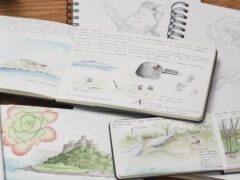Swainson's Hawk Photo Gallery
Adult light morph
Distinctively long-winged large hawk with pointed wingtips. Usually soars with wings slightly raised (dihedral). Light morph adults have dark flight feathers creating a broad, dark trailing edge to the wing. Also note the brown upper breast, creating a hooded appearance.
© Steven Mlodinow / Macaulay LibraryColorado, May 31, 2017Adult light morph
Note the distinctive long-winged shape with pointed wingtips—especially pronounced when the bird is gliding with wingtips swept back, giving an M-shape to the wings.
© Brian Sullivan / Macaulay LibraryCalifornia, August 17, 2019Adult light morph
A large hawk of the open country of western North America. Most individuals have a light belly, dark or reddish-brown chest, and brown or gray upperparts. Most males have gray heads, while females tend to have brown heads.
© Andrew Spencer / Macaulay LibraryColorado, August 02, 2020Not all videos have soundAdult dark morph
Dark-morph Swainson's Hawks can vary from reddish-brown to uniform dark brown, but they usually have a rufous tone to the underwing coverts and pale undertail coverts, as shown here.
© Brian Sullivan / Macaulay LibraryCalifornia, April 25, 2009Adult dark morph
Dark-morph adults usually have a two-toned appearance from beneath created by paler underwing coverts and darker flight feathers, similar to but less pronounced than the pattern of light-morph adults. Note the long wings with somewhat pointed tips.
© Alex Lamoreaux / Macaulay LibraryOregon, June 19, 2019Adult light morph
Large hawk with long, relatively slender wings with pointed tips. Typically soars with wings slightly raised (known as "dihedral"), often teetering in the wind.
© Larry Arbanas / Macaulay LibraryArizona, May 12, 2006Not all videos have soundAdult light morph
Large hawk with long wings. Head and upper breast are brown, creating a hooded appearance. Tail has narrow dark bands, with a broader dark band at the tip.
© Malcolm Gold / Macaulay LibraryKansas, April 16, 2017Adult light morph
Large hawk of open country. Note brown head and breast, with unmarked white belly.
© Timothy Barksdale / Macaulay LibraryArizona, July 24, 1997Not all videos have soundAdult dark morph
Hunts in open country; eats mostly mammals such as ground squirrels on breeding grounds.
© Timothy Barksdale / Macaulay LibraryMontana, July 01, 2000Not all videos have soundAdult dark morph
Dark morph birds can range from reddish brown to fully dark brown, but usually have some rufous tones to the plumage. Note long wings.
© Brian Sullivan / Macaulay LibraryCalifornia, October 12, 2016Juvenile dark morph
Dark-morph immatures can be quite variable in degree of darkness, but usually have some buffy streaking on the body and show pale undertail coverts.
© Margaret Viens / Macaulay LibraryMaine, October 01, 2016Juvenile light morph
Light-morph immatures are mottled brown above, with pale edges to the wing coverts, and have variable dark streaking on the breast. The head is often pale from bleaching.
© Ian Davies / Macaulay LibraryIdaho, September 16, 2018Juvenile
Young Swainson's Hawks have pale edges to the upperwing coverts creating a scalloped appearance.
© Cédric Duhalde / Macaulay LibraryNew Mexico, September 26, 2017Juvenile dark morph
Dark-morph juveniles are variable but usually show buffy streaking on the body and often have pale head from bleaching. Note the distinctive long-winged shape.
© Brian Sullivan / Macaulay LibraryCalifornia, August 19, 2018Juvenile light morph
Often has brown streaks on the chest but may also show brown upper breast and dark flight feathers, like an adult. Juveniles have a narrower, less distinct terminal tail band than adults.
© Brian Sullivan / Macaulay LibraryCalifornia, August 17, 2019Habitat
Breeds in open country with occasional trees, including grasslands, croplands, pastures, hayfields, and sage flats.
© Joshua Schrecengost / Macaulay LibraryMontana, August 19, 2016Compare with Similar Species
Click on an image to compare
Species in This Family
Hawks, Eagles, and Kites(Order: Accipitriformes, Family: Accipitridae)
More to Read
Don't miss a thing! Join our email list
The Cornell Lab will send you updates about birds,
birding, and opportunities to help bird conservation.































